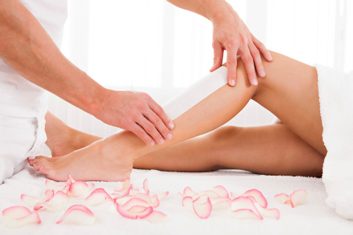What’s new in waxing
Curious about dipping into a professional wax job? Here’s what’s new

Source: Best Health magazine, Summer 2013; Image: Thinkstock
Waxing is, well, hot, hot, hot. Many women’particularly those between 20 and 45’are doing it, according to Leslie Bruce, a managing director for the spa marketing company SpaFinder Wellness Canada. They’re waxing not just legs and bikini line (the most common areas to have waxed), but armpits, arms and genitals. And those looking for smooth, stubble-free skin, regardless of the body part, are turning more and more to professional hair removal.
U.S. stats from IBISWorld Market Research indicate that the waxing and nail salon industry grew by about 4.6 percent annually over the past five years, despite the recession.
‘Waxing has become a ‘need to have’ and not just a ‘nice to have,”’ says Bruce. ‘It’s viewed as maintenance. Regular customers get it done every four to six weeks.’
Enter the dedicated wax bar, popping up in major cities. Day spas have long offered waxing as part of their esthetic services. But at a waxing bar, waxing is the service, with a roster of choices that can include scented waxes, specialized pre- and post-wax products, and even Swarovski crystal decorations for freshly waxed areas.
‘Many people don’t want to spend an hour of their day at a spa appointment,’ explains Lexi Miles, owner of Waxon Waxbar in Toronto. Most customers view waxing as just another item on their to-do list, she says, and want a clean shop and quick, efficient service at a reasonable price. At a wax bar, most procedures take about 15 minutes each, says Miles, and there are often ‘frequent-waxer’ deals. Even men are showing up for manscaping’removing hair on their backs, chests, eyebrows, genitals, arms or legs. At Waxon, they make up about 20 percent of the clientele.
Wax options
Generally, ‘waxologists’ use a combination of strip wax (they smooth it on warm, pat strips of cloth on top and then rip them away) and hard wax (also warm, it adheres directly to the hair and is peeled off when cool). ‘Strip wax is great for larger areas such as legs and arms,’ says Amanda Billings, a supervisor at Wax Hair Removal Bar in Vancouver. ‘It’s quicker.’ But hard wax is a more comfortable treatment for sensitive areas such as the genitals. It pulls the hair out cleanly and doesn’t stick to the skin, so it doesn’t cause microscopic tearing that can increase risk of infection.
Wax enthusiasts are also becoming brand-aware. Miles offers Lycon, originally from Australia and now regarded as the gold standard for waxing in Europe. (Victoria Beckham and Sienna Miller reputedly use only Lycon.) Not only is it formulated with natural ingredients, like resins, beeswax and aromatherapy essential oils, ‘you can remove hair as short as one millimetre and with minimal redness,’ says Miles, ‘which is astonishing.’
Wax Hair Removal Bar seeks out waxes that are natural such as White Queen by Quebec-based manufacturer Épillyss; it contains pine resin, beeswax and a touch of zinc oxide for its antiseptic and healing qualities.
More comfortable hair removal
If you have never been professionally waxed and are queasy about the pain and discomfort, another trend is pre- and post-wax treatments. Waxon carries creams that promise to numb the pain when applied 20 minutes beforehand; there’s even a version for men, cheekily called Numb Nuts.
You can also buy serums that, when used regularly at home after waxing, help to prevent ingrown hairs and eliminate the dark spots and blemishes they can cause. For example, Prince Reigns’a runaway success since Oprah put it on her ‘O list”made from aloe vera, eucalyptus and camomile, works by softening and straightening the hair follicle as it comes back in so that it doesn’t curl and burrow under the skin. Many spas and wax bars recommend at-home use of sugar scrub exfoliants, and antibacterial lotions and body washes, to remove dead skin cells that can trap hairs and prevent them from pushing through.
Regardless of which body part you are having waxed, try to arrange your appointment several days after your period, when you’re least sensitive to pain, and take ibuprofen 15 minutes prior to treatment, advises Pat Cassell-Ogilvie, owner of En Vogue Day Spa in Regina.
Avoid exfoliation and sun exposure the day you get waxed, she advises, since both can irritate your skin. The good news: With a little care, all should go smoothly.
Did you know?
Removing bikini-line hair became common in the 1960s ‘with the arrival, not surprisingly, of the bikini’but the majority of pubic hair was left untouched. Then came the Brazilian craze, which some trace to a 2000 Sex and the City episode in which Carrie Bradshaw got one.
This article was originally titled "Footloose & fuzz-free" in the Summer 2013 issue of Best Health. Subscribe today to get the full Best Health experience’and never miss an issue!




